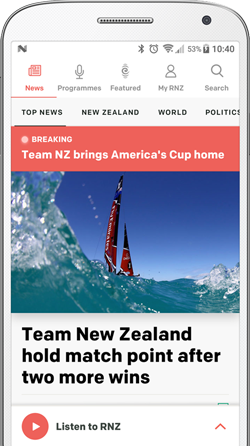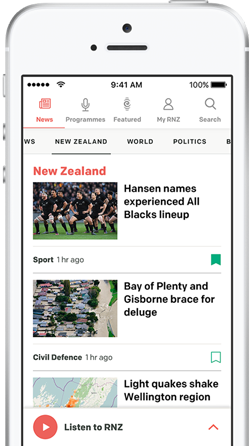The boat that capsized off the coast of Kaikōura in 2022, killing five people had hit a whale, and those who died were trapped in the petrol-contaminated hull, the transport watchdog has found.
It also found the "disorganised" emergency response was hampered with communication problems - but even if emergency services arrived earlier, it would not have changed the outcome of the accident.
Two hours into the i-Catcher excursion in September 2022, it capsized off Goose Bay, killing five of the 11 people on board when they became trapped under the flipped vessel and were exposed to petrol fumes.
The Transport Accident Investigation Commission's 2023 preliminary report found a fuel leak contributed to the five deaths.

Two hours into an i-Catcher excursion in September 2022 the boat capsized off Good Bay, killing five of the 11 passengers. Photo: Supplied / Transport Accident Investigation Commission
Its final report released on Thursday confirmed that, and said the system had not been thoroughly examined.
It found the initial capsize was caused by the boat hitting a whale.
All five of those who died were found within the air pocket under the upturned hull wearing inflated lifejackets, hindering their ability to escape, the report said.
"It is virtually certain that defects in the vessel's fuel system allowed fuel to leak into the air pocket of the upturned vessel reducing the survivability of the accident."
Because they were trapped, they could not activate the emergency beacon, it said.

Photo: Photo / TAIC
"Survivability was reduced by the combination of a toxic environment, cold water, and the confined space," said TAIC Chief Investigator of Accidents Naveen Kozhuppakalam.
Search and rescue effort hampered by communication problems
The report described the emergency response as "disorganised".
The five passengers and the skipper who survived had managed to climb on top of the upturned boat, and the skipper dialled 111 at 10.11am.
Atop the hull, the skipper knocked on it to see if any of the five underneath the boat would respond.

Photo: Photo / TAIC
"In response, knocking from underneath the upturned hull was heard by the skipper and passengers atop the hull," the report said.
The skipper then yelled that help was on the way, while remaining on the line with the police.
"By 1022 the knocking from underneath the hull had stopped, and the skipper then told the Police communicator to send divers urgently."
It would be another five hours before divers arrived.

The boat that capsized off the coast of Kaikōura in 2022, killing five people. Photo: Supplied/Transport Accident Investigation Commission
The emergency call taker tried to reach the local constable who was busy with another matter, and there were no other officers on duty.
Three efforts to page the local Coastguard went unanswered.
At 10.24am the Maritime NZ Rescue Coordination Centre sent out a mayday call, which a recreational boat answered. Ten minutes later, a Coastguard member confirmed they were responding.
The recreational boat arrived at the i-Catcher about 10.40am, rescuing those atop the hull - though the skipper stayed behind. He told the emergency call taker he wanted to dive underneath to try and rescue the five people trapped.
"The Police communicator responded that the Coastguard was on its way, and mistakenly provided the skipper with incorrect information, informing them that the Coastguard vessel was equipped with dive gear and that the two winch-capable helicopters would be able to lift the boat."

Photo: Photo / TAIC
A private helicopter flew over to assess the scene, and the skipper indicated people were trapped, but the helicopter could not conduct a rescue as it did not have a winch.
The Coastguard arrived shortly before 11am and rescued the skipper, but did not have divers to reach those trapped.
The police dive squad began assembling about 11.30am in Wellington, and flew to Kaikōura.
They reached the i-Catcher and recovered the bodies by 3.40pm.
The report said that even if the dive squad was deployed earlier, it would not have changed the outcome of the incident.

Photo:
However: "Kaikōura, an area of significant maritime activity, did not have a rescue plan, leaving the area susceptible to a disorganised emergency response," it found.
Recommendations
TAIC made a raft of recommendations, including that Maritime NZ improve its surveying system to ensure entire fuel systems are inspected.
Maritime NZ has implemented that recommendation already.

Photo: Photo / TAIC
TAIC also suggested all crew should carry personal locator beacons - as well as the emergency beacon every boat has - and educated people about how to deflate life jackets.
Those who died were Catherine Margaret Haddock, 65, and Susan Jane Cade, 63, of Lower Hutt; and Diana Ruby Stewart, 68, Peter Charles Hockley, 76, and Maureen Patricia Pierre, 75, all of Christchurch. All were members of the Nature Photography Society of New Zealand.
Mark and Sharlene Ealam who ran Fish Kaikoura, the business the group had chartered the vessel through, said at the time it was an "unprecedented tragedy".
Assistant Police Commissioner Mike Johnson said police were working with Rescue Co-ordination Centre New Zealand (RCCNZ) in response to the findings of the report.
He said a joint Maritime Rescue Plan for Tasman had been prepared and was in the final stages of being "signed off".
"Our on-call practices and tasking processes have been streamlined and continue to be improved.
"Standard operating procedures have also been updated to include that Police's National Dive Squad must be contacted for advice and availability in life-threatening water rescue events," Johnson said.
He said police were putting the report's recommendations in place and looking at where they could support partner agencies to do the same.
Maritime NZ director Kirstie Hewlett said they supported the report's recommendations where they related to how the organisation worked with New Zealand Police or other co-ordinating authorities in the search and rescue sector.
"As regards to the TAIC recommendations relating to Maritime NZ, we have either already actioned these, have actions in progress, or have partially accepted recommendations, but may be delivering these in ways that achieve the outcome, but through different means," Hewlett said.
Hewlett said she understood the reports unveiling - two-and-a-half years after the incident - would be tough on the survivors and friends and family of the victims.
"We want to extend our sincere condolences to everyone impacted by this tragic incident," Hewlett said.
Owners of the i-Catcher, Mark and Sharlene Ealam, expressed their thanks to all the organisations who worked to investigate "this terrible tragedy" and compiled the report.
They said they could not comment on the specific recommendations but they were sure the report would help improve safety on the country's waters.
"We can only hope that with this final report and its recommendations that people can somehow find some closure and move forward with their lives.
"It has been an awful time for all those involved, and our thoughts and condolences are again with the family and friends of those who died, and with those who survived," they said.
Sign up for Ngā Pitopito Kōrero, a daily newsletter curated by our editors and delivered straight to your inbox every weekday.





